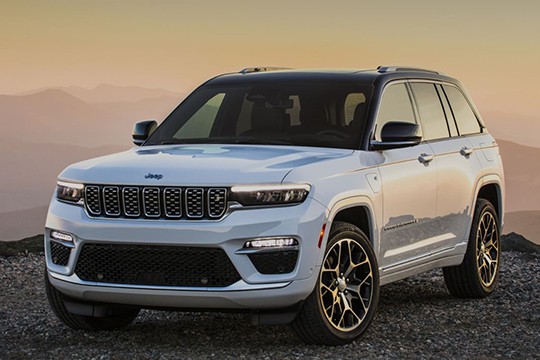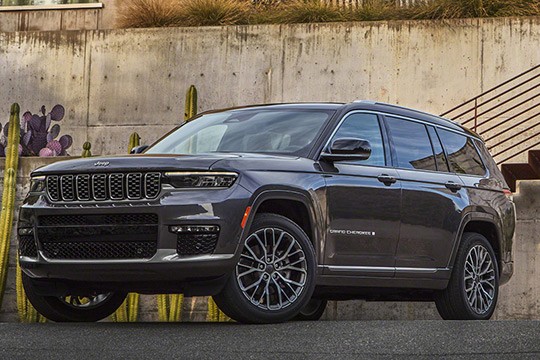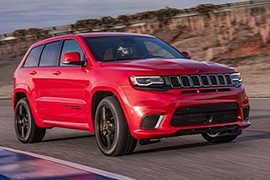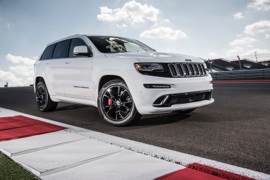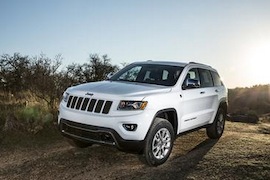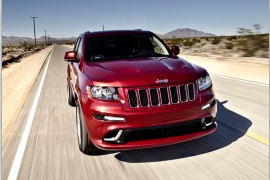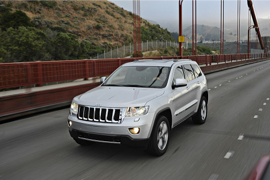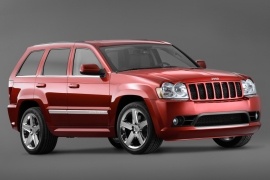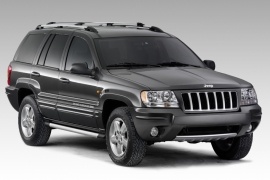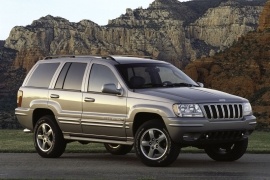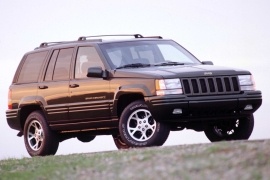JEEP Grand Cherokee Models/Series Timeline, Specifications & Photos
First production year: 1992
Engines: Hybrid gasoline, Gasoline, , Diesel
Body style: SUV (Sports Utility Vehicle)
Jeep introduced the fifth generation of the Grand Cherokee lineup in 2021, and it proved worthy of its nameplate but added more luxurious and advanced technological solutions.
After seven million units sold, the Grand Cherokee was already a respected and worldwide known product. Ever since its first generation, in 1992, it offered great off-road performance and a comfortable interior. Over the years, the American SUV became more and more luxurious and proved to be performant on highways too.
The 2021 Grand Cherokee was so well designed that it even didn’t need a badge to recognize its brand and nameplate. Its seven vertical slats at the front were a distinctive sign for the Jeep brand, while its narrow headlights and fat bumper made a connection with its predecessors in terms of design. Jeep built the vehicle on the same platform used by the Stellantis group for the Alfa Romeo Stelvio. The designers managed to create a lower roofline for a sleeker appearance. The raked-forward C-pillars remained a clear characteristic for the Grand Cherokee.
While the first generation of the Grand Cherokee sported a spartan interior with just a few amenities, the 2021 model could compete in the luxury segment thanks to the use of leather, high-tech, and comfort features. I provided 144.6 cu-ft (4,096 liters) of interior space for the cabin. When the rear, split-folding bench was lowered, it allowed a trunk increase of up to 37.7 cu-ft (1,067 liters). For the front occupants, Jeep installed a Uconnect infotainment system with up to three 10.1” screens.
From the technical point of view, the most technologically advanced powertrain was the 4xe version. It featured a hybrid powerplant that combined a turbocharged inline-four and an electric motor mated to an eight-speed automatic transmission.
Jeep introduced the Grand Cherokee L at the beginning of 2021, just in time to be deployed at full scale when the world pandemic was done.
Chrysler promised a certain level of autonomous driving experience and a hybrid version for the Grand Cherokee's fifth generation. It was a big gamble, and they knew it. The customers started to demand more eco-friendly vehicles than hard-core off-road cars, and the carmaker worked hard to deliver what the market asked for, even though in the beginning, the engineers just carried over the previously used engines from the Grand Cherokee MK IV.
The design team burned the midnight oil to finish the car's final touches during the pandemic situation. It exchanged some terabytes of information during the extended Zoom discussions, but the final result was respectable. With wider gaps between the seven vertical slats, its front fascia resembled the 2022 Grand Wagoneer, while the extended greenhouse made the SUV look sportier than before.
Inside, the 2021 Grand Cherokee L was available with three rows of seats, either with room for six or seven occupants. The middle and the last row were folding flat and slide forward to increase the trunk space. Also new was its 10.25-inch digital gauge cluster with nearly two dozen different menus from which the user could select, including driver-assist technologies.
The engineers relied on the already proven engines from the fourth-generation of the Grand Cherokee under the hood, but they worked harder for the transmission systems. There were three versions for the mid-size SUV. The base version featured an all-wheel-drive system without low-range gear. Only the second and the third levels were available with that, and the latter featured an electronically controlled limited-slip differential.
When launched in 2018, the Grand Cherokee Trackhawk was the most powerful SUV in the world, and, unlike its siblings, it was made to tear-up asphalt, not trails.
With an increased demand for high-performance SUVs, Jeep didn't want to stay aside and watch Porsche, BMW, or Mercedes-Benz dominating the segment and mixed some of its best assets and parts to create an incredible machine: the Trackhawk. It wasn't the first high-performance Grand Cherokee ever made by Jeep. In 2006, the carmaker also produced the Grand Cherokee SRT8, which was also a tire-shredding monster.
Jeep didn't want to be subtle with the Trackhawk version of the Grand Cherokee. Thus, it developed a new aerodynamic package that made the car looks fiercer on the road than its siblings. Like any other Jeep ever made, it featured a seven-slat grille. The massive front bumper sported a broad lower grille in the apron flanked by two air-intakes that cooled the front brakes. Since it wasn't built for off-roading, the Trackhawk received a different suspension package with lower ground clearance. To complete the sporty image, Jeep added a specific set of wheels and a quad-exhaust system.
Inside, the customers were greeted by high-bolstered bucket seats at the front adorned with the "Trackhawk" lettering on the seatbacks. At the front, the driver was spoiled with a flat-bottom steering wheel decorated with the Trackhawk badge at the bottom and sporting aluminum paddle shifters. The rear seats, on the other hand, looked almost standard, apart from a specific vertical seven-slat theme embroidered on them.
Under the hood, Jeep installed the same engine used in the Charger and Challenger high-performance vehicles: the 6.2-liter supercharged V8 Hemi powerplant. Unlike its RWD siblings, the Grand Cherokee Trackhawk got an eight-speed automatic transmission that sent the power in all corners.
Jeep introduced the second generation of the SRT8 lineup in 2012 as the high-performance version of the WK Grand Cherokee.
The American automaker noticed that customers were more attracted to higher-powered SUVs, such as the Porsche Cayenne, BMW X5, or Mercedes-Benz ML with AMG engines, and so it considered offering something to please its customers. Thus, starting with the third generation of the Grand Cherokee, Jeep offered a special version that was more powerful and street-oriented than its stablemates. Things evolved quickly, though, and in 2012 introduced, the second generation of the SRT8. The name came from the Street and Racing Technology department that worked on the car. It was a sort of an AMG or M Power for Chrysler.
With its meaner look, the 2013 Grand Cherokee SRT looked like a street fighter compared to the rest of its siblings. Its ground clearance was lower, and the broad lower grille in the front bumper looked business. The five-spoke alloy wheels exposed the red brake calipers and large rotors from its profile. Finally, at the back, a roof spoiler adorned the top of the tailgate while a pair of big and round pipes peaked from under the bumper.
Inside, the high-powered version sported aluminum-looking trims on the center console and stack. At the same time, the steering wheel sported the SRT badge on the airbag's cover instead of the Jeep's. Moreover, the same three letters were embroidered on the high-bolstered front seats. As a clear statement of its performance, on the center console, Jeep installed a rotary knob that adjusted
the car's driving modes that also included a launch-control function.
Under the hood, the automaker installed a supercharged 6.4-liter V8 Hemi engine that provided 471 hp (477 PS) that sent into all corners via an eight-speed automatic transmission.
The fourth generation of the Jeep Grand Cherokee was introduced in 2009 at the New York Auto Show and it was facelifted in 2013.
For the 2014 model year, the Grand Cherokee received more updates in terms of on and off-road performance. Since Chrysler is into an alliance with the Fiat, the Italians couldn't let a facelifted model go out without several exterior improvements.
On the outside, the 2013 Grand Cherokee showed different headlights and front bumper design. The Trailhawk version received additional underbody shields and higher ground clearance. With a new set of wheels and off-road tires, the Trailhawk was ready to tackle serious off-road tracks. Permanent tow-hitches front and back were installed. An air-suspension was installed and that allowed an increase up to 11” (28 cm) of ground clearance.
Inside, there were new modifications in terms of infotainment and instrument cluster. The new Uconnect system was carried over and adapted from Fiat. It was available with several cameras to show a 360 degrees view around the car. Trailhawk-specific interior touches included black leather and performance suede seats with red accent stitching and Mopar slush floor mats front and rear.
For the engine compartment, the Grand Cherokee was offered with a new 3.0-liter turbodiesel V6 unit, that complemented the 3.6- and the 5.7-liter units. All versions were mated as standard with an 8-speed automatic transmission from ZF.
Jeep launched the second generation of the SRT8 version for the Grand Cherokee in 2012, proving that a big chunky American SUV can keep up with sports cars, at least in straight-line acceleration.
The American automaker had tried to produce a high-powered Grand Cherokee since 1997, when it unveiled the 5.9-liter version. Then, in 2006, it brought the first fully-fledged SRT8 moniker on the SUV's tailgate, establishing a new standard in power for the brand. By 2012 though, thanks to the improved platform inherited from Mercedes-Benz, it launched a second iteration of the nameplate.
While many customers were not exactly pleased by the new model's look, the 2012 SRT 8 had enough aces up its sleeves to convince them. The ground clearance was diminished compared to its siblings, a broad air intake was placed in the redesigned lower bumper and adorned with LED daytime running lights, and the seven-slat grille got chromed trims. Yet, unlike its predecessor, it didn't look that much different than the rest of the Grand Cherokee range from its profile, bar the unique five double-spoke design wheels.
Inside, it was a huge step forward in terms of quality, fit and finish. In addition, customers could enjoy the high-bolstered bucket seats at the front sporting SRT lettering embroidered on the seatbacks' fronts. Another unique option for this high-powered version was for the real carbon-fiber trims. The instrument cluster looked similar to other ones installed on the Grand Cherokee versions, but this one featured new options for the LCD placed between the dials.
Powering this 5150 lbs (2336 kg) beast was a 6.4-liter naturally-aspirated V8 that featured cylinder deactivation. Still, due to the old five-speed automatic, it couldn't keep fuel efficiency to stunning values.
A popular choice in the SUV market, the Jeep Grand Cherokee’s history started back in the early ‘90s.
Designed for customers looking for both off-road capabilities and good urban skills, the Grand Cherokee was fitted with an advanced four-wheel-drive system, however, driving it around town was fun also.
Not fitted with the most spacious cabin, the SUV could have fell off the list for larger families, as the cargo area was rather small compared to other vehicles available on the market.
Under the hood, the JGC came with a choice of 3 engines, a V6 and two V8s.
While you would think opting for the V6 would have come with an improved fuel consumption, it was not the case with the 2010 model. Thus, many customers opted for the V8s, with power ranging from 357 hp to 420 hp with the SRT8 model.
The most powerful V8 unit rocketed the JGC to 100 kph in around 4.7 seconds.
Offered in three trim levels, the SUV was available either with a rear-wheel-drive or a four-wheel-drive system, while the SRT8 was only available with the AWD system.
Safety wise, the JGC featured antilock disc brakes, stability control, side curtain airbags with a roll-over detection system and an optional trailer sway control.
The materials used inside the cabin were never the Jeep’s strongest point, however, the refreshed 2010 model upgraded their quality to make it more appealing to the customers.
Ever since the Red Lil Express truck, Americans started to understand that a powerful SUV might be a better choice than a sports car, and Jeep made that even clearer with the introduction of the SRT-8 variant in 2005.
Jeep worked with SRT (Street & Racing Technology) to create the monster-WK Jeep, unveiling the result at the 2005 New York International Auto Show. Unlike its siblings, it had no off-road abilities. Moreover, its all-wheel drive system was mainly used for better acceleration times and slippery road conditions. Thus, it was the second-fastest Chrysler product behind the mighty Dodge Viper.
At first sight, the SRT-8 version was different than its regular sibling because it stood lower to the ground. In addition, the front apron was extended, so it sat just 7" (170 mm) above the asphalt. On the sides, the enlarged wheel arches and the SRT-8-only unique 20" light-alloy wheels were unusually big for those times. At the back, the go-fast version of the Grand Cherokee featured a dual exhaust system that peaked out its chromed tips from the middle of the rear bumper.
Jeep also made the car's interior looks a little bit sportier, with high-bolstered front bucket seats that sported the SRT-8 logos embroidered on their seatbacks. At the back, the automaker placed a similar bench as on the rest of the range, albeit it was leather-upholstered.
Under the hood, Jeep installed a 6.1-liter HEMI engine carried over from the Dodge Charger SRT8. It produced more than 400 horses and sent them into all corners via a five-speed automatic transmission from the Mercedes-Benz basket. The rear axle was fitted with a Dana 44 differential, and the end result was a 0-60 mph (0-97 kph) time in less than four seconds.
The third generation of the Jeep Grand Cherokee was born under the DaimlerChrysler alliance and benefited from the know-how of both of its parents. But the main ingredients were from the U.S. side.
When it comes to luxury SUVs, bigger was always better. A bigger wheelbase and a longer body made the Grand Cherokee more appealing for its customers. Due to the new proportions, it looked sleeker than before. And the technology hidden underneath the car confirmed the evolution.
The new look of the car kept the seven vertical slats on the grille. The new design for the headlights made a step away from the classic, rectangular, type. The overfenders on the wheel-arches, both front, and back, gave the car a sportier look. And it wasn't for nothing.
Inside, the car featured the same luxurious interior as before. The base trim level featured cloth seats, but the top-of-the-range ones were fitted with leather upholstery, touchscreen infotainment systems, and automatic transmission.
For the drivetrain, the 2005 Grand Cherokee was a revolutionary model. It featured a front-wheel independent suspension and a five-link rear axle. It was available with or without low-range gear. Power came from a standard 3.7-liter engine in the Laredo trim level and went up to a 5.7-liter unit, Hemi V8 engine. For the European market, the Grand Cherokee was available with a 3.0-liter V6 diesel unit. All versions were mated to a standard 5-speed automatic transmission. The versions with low-gear transmission featured the QuadraDrive II system, with front and rear limited-slip electronically controlled differentials, with multi-clutch plates.
DaimlerChrysler unveiled a facelifted version for the WJ Grand Cherokee in 2003 for the last two years in production before the 2005 WK generation replaced it.
While the Grand Cherokee was already well known in the U.S., its presence on the European market was slim, mostly due to its size and low fuel efficiency. It was not a car for tight corners and narrow streets as those from Europe. Moreover, even though it offered a turbo-diesel version, it was too weak for the car's size. But the 2003 model came and fixed that too.
On the outside, the 2003 Grand Cherokee received a minor exterior update. At the front, the car sported a new design for the signature seven-slat vertical grille. In the lower part of the bumper, the carmaker placed round fog lights instead of the previously used rectangular, horizontal ones. Jeep installed a metallic shield under the engine compartment to emphasize the vehicle's offroad ability and extended it all the way to the front, under the bumper. On the sides, the 2003 model received additional turn signals.
Inside, Mercedes-Benz helped Chrysler in developing a friendlier interior. Jeep changed the older black dials inside the instrument cluster to white-faced ones with black needles. Other changes included fewer wood trims on the center stack and center console.
Under the hood, the most significant novelty for the Europeans was the 2.7-liter turbo-diesel engine carried over from Mercedes-Benz. It replaced the older WM-Motori 3.1-liter unit and provided more power and torque while offering better fuel efficiency. For the U.S. market, the most important addition in terms of engines was the 4.7-liter High Output unit that provided 30 more horses.
Developed in just 28 months and sharing only 127 parts with its predecessor, the 1999 Jeep Grand Cherokee – WJ represented a leap forward for the Jeep's flagship model.
Made during the DaimlerChrysler alliance, the Grand Cherokee WJ was produced on four continents and featured significant technological upgrades. Some of them were carried over from Mercedes-Benz, while the two carmakers jointly developed others. Its all-wheel-drive system and lighter, evolved engines led to better fuel efficiency as well.
From the outside, it was clearly a Jeep. Its seven-slat grille was already a signature element. Since it was developed at the beginning of the new-edge-design era, it sported rectangular headlights but with rounded corners. Its bumper sat high to improve the approach angle, and only those who didn't want to take it off-road chose the optional aluminum side steps, which decreased the break-over angle. Its flared wheel-arches gave the impression of a true off-road warrior. Jeep even marketed it as "the most capable SUV ever."
Inside, depending on the engine option and trim level, the carmaker installed comfortable seats with velour upholstery, with an option for a leather-clad interior. The carmaker installed a wide center console for both levers between the front seats: the gear-selector and the transfer case lever. Jeep placed the audio system at the top on the center stack while in the mid-area installed the climate control dials and two vents. The Grand Cherokee sported two large dials for the speedometer and tachometer and another four gauges for various systems in the instrument cluster.
Under the hood, the carmaker installed a choice of four engines: an inline-six carried over from the Cherokee paired with a four-speed automatic, a 4.7-liter V-8 mated to a five-speed automatic, and two turbo-diesel powerplants for the European market. The 2.7-liter unit was carried over from Mercedes-Benz.
Jeep was already part of Chrysler when the American automaker decided to continue the story of the Grand Wagooner but in a different way.
The introduction of the 1993 Grand Cherokee at the North American International Motor show in 1992 was one of the most spectacular unveilings in automotive history. Then, Bob Lutz, who was the big kahuna at Chrysler at that time, entered the Cobo Hall through a window driving a red Grand Cherokee. Yet, the model was not entirely a new concept.
Jeep entered the luxury SUV segment by introducing this new lineup. It had the proper badge and expertise to create one of the best SUVs on the market. Larry Shinoda penned the car when in 1987. He made a rugged yet appealing styling for the SUV. The car featured a classic, seven-slat Jeep grille flanked by two rectangular headlights. On the sides, the Grand Cherokee ZJ (as it was known) featured plastic panels that protected the bodywork against scratches.
Inside, the automaker installed a classic interior with two bucket seats at the front and a folding bench seat at the back. However, despite the car's size, it wasn't as spacious as it seemed. In addition, the driver was separated from the side passenger by a wide and tall center console. In the instrument cluster, the green illumination of the dials was appreciated by those who drove the car for longer distances, especially at night.
Under the hood, the Grand Cherokee was introduced with the same inline-six 4.0-liter offered for the Jeep Cherokee. Then, in 1993, the big SUV received a 5.2-liter V8. Later, in 1998, the automaker added a particular version fitted with a 5.9-liter Magnum V8 powerplant.
